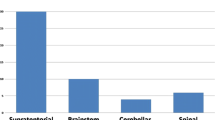Summary
Background. Since advent of MRI, brain stem Cavernous Malformations (CM) can be easily diagnosed, and their curative surgical resection considered under precise conditions. The authors report a consecutive series of twelve patients with CMs surgically treated and histopathologically confirmed. Eleven of the cases had bled (six more than once). In this study special emphasis has been put on the pre and post-operative functional status of the patients, by using the 100 Karnofsky scale (KS).
Method. Surgical approaches were: 1°) supra-occipital transtentorial for 1 thalamomesencephalic and 1 quadrigeminal plate CM, 2°) suboccipital infratentorial supracerebellar for 1 dorsolateral mesencephalic CM, 3°) retrosigmoid through the cerebello-pontine angle for 3 pontine and/or medullary CM, 4°) suboccipital intertonsillar for 6 CM located under the floor of the IVthventricle.
Completeness of removal was checked by postoperatoire MRI. It was complete in 11 cases and only partial in 1 (i.e., in the case with the progressing mass-effect presentation). There was no post-op death. Follow-up ranged from 1 to 7 years.
Findings. Preoperatively: 2 patients were operated on in a comatose state (KS≤20), 5 were in state of functional dependance (K≤60) and 5 had severe neurological deficits but were still of independant functional status (KS≥60). At one year after surgery: 3 patients had a KS≥80 (i.e., they could resume their prior normal life), 6 had a KS between 60 and 80 (i.e., they were independant) and 3 had a KS below 60 (i.e., they were dependant especially for walking).
Interpretation. Our results, as well as the data harvested from the literature, plead for advocating radical surgical resection at least in patients with exophytic CMs having bled. As a matter of fact, study of the natural history shows that in brain stem CMs, the bleeding risk amounts to 21% per year per patient. Review of literature shows evidence that radiosurgery did not prove effective and/or even innoccuous.
Similar content being viewed by others
Author information
Authors and Affiliations
Rights and permissions
About this article
Cite this article
Sindou, M., Yada, J. & Salord, F. Functional Results After Microsurgical Resection of Brain Stem Cavernous Malformations (Retrospective Study of a 12 Patient Series and Review of the Recent Literature). Acta Neurochir (Wien) 142, 843–853 (2000). https://doi.org/10.1007/s007010070069
Issue Date:
DOI: https://doi.org/10.1007/s007010070069




